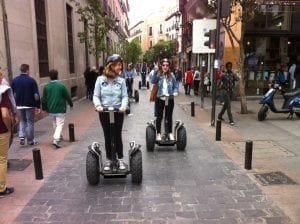Urban Mobility Vehicles (UMV)
The main guidelines of the new Mobility Ordinance regarding Urban Mobility Vehicles (UMV) will be the following:
- Classification in typologies A, B, C0, C1 and C2:
For these new types of vehicles that are becoming more and more frequent in our city (all types of electric scooters,segways, etc.), the classification made by the General Directorate of Traffic in its Instruction 16/V-124 is adopted.
- Minimum age 15 years old. Driving with headphones is prohibited. Types B and C must have bells, lights and reflective elements:
The age allowed to drive a personal mobility vehicle on public roads and spaces is 15 years old. Children under 15 years of age may only use personal mobility vehicles when they are suitable for their age, height and weight and circulate on authorized and guided routes (from the age of 10) or outside traffic areas, in areas closed to traffic, and accompanied and under the responsibility of their parents or guardians. In the case of transporting persons in an approved device, the drivers must be of legal age.
As is already the case with bicycles, persons under 16 years of age using urban mobility vehicles of types A and B (electric scooters and Segways) must wear helmets.
VMUs of types B and C must have a duly approved bell, lights and reflective elements.
- Circulation of urban mobility vehicles: on the roadway of certain streets and bicycle paths:
Depending on the different types of VMUs, they may circulate on bicycle lanes, residential streets (20 km/h limit), protected bicycle lanes and cycle paths, bicycle sidewalks (only A and B only), and on the following B), bike paths (only A and B), bike paths (only A and B) coexistence zones 30 (B and B) coexistence zones 30 (B and B) coexistence zones 30 (B and C), all roads less than 30 kilometers per hour and bicycle lanes (C), and public parks where bicycles are allowed.
The parking of the more voluminous type C type of VMUs would be allowed on the parking strips of the roadway, and type A and B VMUs (electric scooters and Segways) would be allowed under a regime similar to that of bicycles (bike and motorcycle reservations, on the sidewalk under certain conditions).
- Economic activities: insurance, helmet (A and B), authorization of itineraries for groups up to 8 people plus guide:
Urban mobility vehicles used for economic activities, such as sightseeing tours, must have compulsory civil liability insurance to cover possible damages that may be caused to third parties in order to be able to circulate.
In addition, users of types A and B for these activities must wear helmets.
In these cases, additionally, type A and B vehicles may circulate in groups of a maximum of 8 persons and guide along predefined routes with prior municipal authorization.
- Rental and shared-use VMUs: insurance, redistribution, maintenance and technical controls. Concession for citywide coverage and responsible use of public space:
Urban mobility vehicle services for rent and shared use are expressly regulated. The company owning the vehicles must have an insurance policy that covers civil liability for damages that may be caused to the user, to other persons and property, as well as to the municipal patrimony.
They shall be subject to the schedule of controls and preventive and corrective maintenance activities required by the technical service of the owner, manufacturer, distributor or authorized third party.
Shared urban mobility vehicle services without a fixed base will be managed through a municipal concession that ensures, in addition to the above points, the coverage of the service throughout the city.
Source: Madrid City Council


